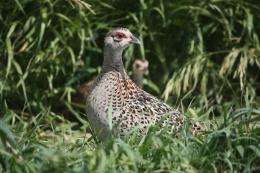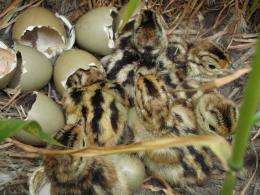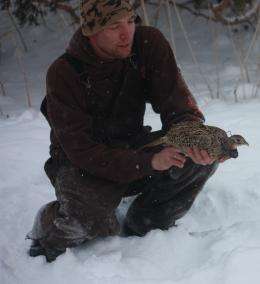Nesting habitat key to pheasant numbers

(Phys.org) —With record low pheasant numbers, hunters are looking at a tough season, but South Dakota State University wildlife researchers predict the birds can rebound, with proper management.
Increasing the pheasant population comes down to nesting habitat, according to research conducted by natural resource management graduate students Brian Pauly and Josh White.
Their work was supported by the South Dakota Department of Game, Fish and Parks with matching federal funds through the U.S. Fish and Wildlife Service.
Average annual survival of adult pheasants is typically 40 to 50 percent, said Pauly, who is now a South Dakota Game Fish and Parks Private Land Biologist in Huron. "Replacing those losses through egg and chick production is the key to the whole population dynamic."
Pauly examined whether pheasants could successfully nest in winter wheat, while White, a range/wildlife biologist in Idaho working on the Sage Grouse Initiative, looked at the potential effect of changes in Conservation Reserve Program land.
Brood count tumbles
The 2013 Game, Fish and Parks pheasant brood survey showed a 64 percent decrease compared to 2012. The report, prepared by senior upland game biologist Travis Runia, cites habitat loss and unfavorable weather as factors.
According to SDSU associate professor of natural resource management K.C. Jensen, the 2007 and 2008 counts along the three 30-mile routes in Brookings County averaged 18 to 33 broods per route. This year the numbers were one, two and three broods.
In the brood survey, Runia cited SDSU research showing only a 50 percent survival rate for hens from Aug. 15 to Nov. 15 in south central South Dakota, where bird numbers are usually high. Runia relies on research data to make management recommendations.
Jensen agreed that the prolonged winter and cold wet spring affected survival. "The fat stores had been largely used up."

However, he said, "the overriding factor is the loss of habitat. Birds just don't have the cover they need, particularly in the eastern part of the state."
Grasslands important for nesting
White looked at brood data from 2006 through 2010 and modeled locations in eastern South Dakota where birds were abundant. He found that the "CRP grasslands are really important for nesting, brood-rearing and winter survival."
He explained that wheat and cattle-grazing make for a more diverse landscape in central South Dakota, so CRP is less important. In terrain dominated by row-crop agriculture, the presence of CRP plots is crucial to pheasant production.
A report entitled A Guide for Landowners and Pheasant Enthusiasts says an ideal landscape for pheasants is a combination of 70 percent croplands and 30 percent grasslands. White explained that beyond that threshold, pheasant numbers tend to decrease.
Ben Lardy, farm bill biologist with Pheasants Forever in Webster, said that White's study reinforces the importance of idle grassland habitat. Through the Conservation Reserve Enhancement Program, begun in 2009, landowners are given additional financial incentives to set aside marginal land as idle grassland. The state Game Fish and Parks Department tacks on an additional 40 percent to landowners' rental rates with the stipulation that they open up the land to public hunting for the life of the contract.
Along the James River Watershed, 85,000 acres have been enrolled and funds are available for 15,000 more, Lardy explained.
Winter wheat shows promise
Research on winter wheat as nesting habitat for ducks spurred Pauly's work: "I started to wonder if the same was true for pheasants." His study focused on Lyman County in central South Dakota which traditionally has some of the highest pheasant harvest rates as well as winter wheat acres.

"It all starts with a nest the size of a paper plate, getting that nest to survive for roughly a month," Pauly said, "but sometimes that's a tall order."
He tracked hens and chicks using radio collars in the spring and summer of 2011 and 2012. Those years included both wet weather and the start of the drought.
Hen pheasants were equally successful nesting in idle grasslands and winter wheat, but they were 2.5 times more likely to nest in grasslands than winter wheat, according to Pauly.
"That was real encouraging," he said, but cautioned that "winter wheat is not the answer, but it's another piece of the puzzle that can benefit pheasants. It's simply another tool land managers can use to help bridge the gap between agriculture production and wildlife management."
Building on Pauly's research, the Wildlife Habitat Incentive Program pays landowners for planting winter wheat along with other cover crops in the fall as nesting and brood-rearing habitat, according to Lardy. The cover crops complement the wheat rotation and provide many soil health benefits.
"Weather and predators are factors, but if there is good habitat, the pheasant population will rebound," Jensen said. After the winter of 1997, pheasant populations decreased, but "within three years, they were back, because the habitat was there."
Pauly concurred: "If you've got habitat for the birds to go to, they can overcome short-term weather-related challenges; long-term declines are a direct result of habitat loss." Even in this challenging year, he anticipates that there will be pockets in the state with high quality habitat that will have good pheasant numbers.
Provided by South Dakota State University



















